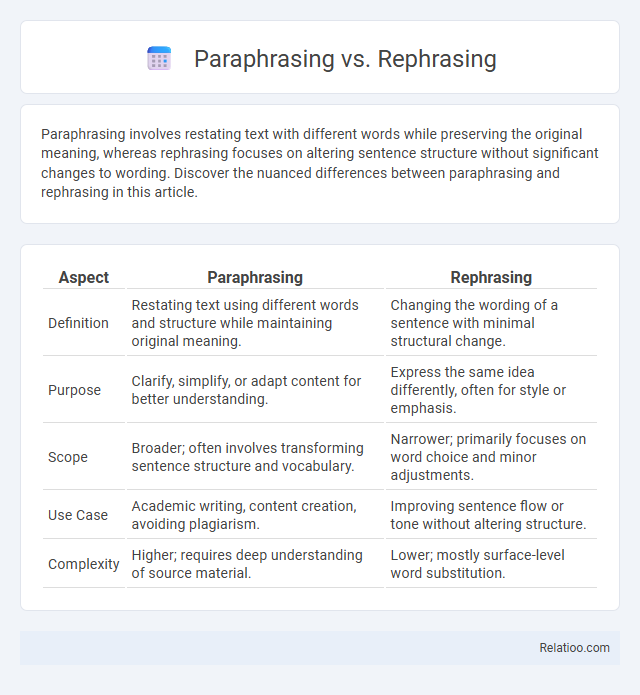Paraphrasing involves restating text with different words while preserving the original meaning, whereas rephrasing focuses on altering sentence structure without significant changes to wording. Discover the nuanced differences between paraphrasing and rephrasing in this article.
Table of Comparison
| Aspect | Paraphrasing | Rephrasing |
|---|---|---|
| Definition | Restating text using different words and structure while maintaining original meaning. | Changing the wording of a sentence with minimal structural change. |
| Purpose | Clarify, simplify, or adapt content for better understanding. | Express the same idea differently, often for style or emphasis. |
| Scope | Broader; often involves transforming sentence structure and vocabulary. | Narrower; primarily focuses on word choice and minor adjustments. |
| Use Case | Academic writing, content creation, avoiding plagiarism. | Improving sentence flow or tone without altering structure. |
| Complexity | Higher; requires deep understanding of source material. | Lower; mostly surface-level word substitution. |
Introduction to Paraphrasing and Rephrasing
Paraphrasing involves expressing the original text's meaning using different words and sentence structures while maintaining the core message, crucial for academic writing and avoiding plagiarism. Rephrasing specifically targets altering sentence construction and word choice without significantly changing the meaning, often used for clarity and style improvement. Both techniques enhance content originality and comprehension, yet paraphrasing demands a deeper understanding of the source material compared to rephrasing.
Defining Paraphrasing
Paraphrasing involves restating text or speech using different words while preserving the original meaning, enhancing clarity and originality. Rephrasing typically refers to altering sentence structure or wording to improve flow without necessarily changing the content's essence. Defining paraphrasing emphasizes its role in avoiding plagiarism and demonstrating comprehension by transforming source material into unique expressions.
Defining Rephrasing
Rephrasing involves expressing the same idea using different words or sentence structures without altering the original meaning, emphasizing clarity and simplicity. Paraphrasing extends this by restating information more extensively, often adding interpretation or explanation for better understanding. Understanding the distinction highlights that rephrasing is more about minor adjustments, while paraphrasing encompasses broader restatements to enhance comprehension.
Key Differences Between Paraphrasing and Rephrasing
Paraphrasing involves restating a text or passage using different words and sentence structures while preserving the original meaning, often resulting in a more detailed or expanded version. Rephrasing typically means altering the wording or phrasing of a sentence without significantly changing its length or complexity, focusing on clarity or style. The key difference between paraphrasing and rephrasing lies in paraphrasing's emphasis on deeper rewriting for originality and content variation, whereas rephrasing centers on minor adjustments to improve expression or readability.
When to Use Paraphrasing
Paraphrasing is essential when you want to present someone else's ideas in Your own words, maintaining the original meaning while avoiding plagiarism. Use paraphrasing to explain complex concepts more clearly or to integrate research smoothly into your writing. Rephrasing typically involves changing sentence structure or wording slightly without significant alteration, while summarizing condenses the main ideas into a brief overview.
When to Use Rephrasing
Rephrasing is ideal when you need to clarify or simplify a specific sentence without changing the original meaning, making your message more accessible to your audience. Unlike paraphrasing, which involves restating entire passages for originality or emphasis, rephrasing targets individual phrases or sentences for better readability. You should use rephrasing when your goal is to enhance sentence structure or tone while preserving the original content.
Benefits of Paraphrasing
Paraphrasing enhances your writing by allowing you to convey information in a unique way while maintaining the original meaning, improving clarity and originality. It helps avoid plagiarism by transforming source material into fresh content tailored to your audience's needs. Unlike simple rephrasing, paraphrasing involves deeper understanding and restructuring, which strengthens comprehension and communication skills.
Benefits of Rephrasing
Rephrasing enhances clarity and improves the flow of your writing by restating ideas in a simpler or more precise manner. It helps avoid plagiarism by presenting original content in a unique way while preserving the intended meaning. Your audience benefits from easier comprehension and engagement when information is effectively rephrased.
Common Mistakes in Paraphrasing and Rephrasing
Common mistakes in paraphrasing and rephrasing often include changing only a few words while keeping the original structure, which can lead to plagiarism. You must avoid simply swapping synonyms without altering the sentence flow or meaning to ensure your content is genuinely unique and clear. Effective paraphrasing requires a deep understanding of the source material to accurately convey ideas in your own words while maintaining the original intent.
Choosing the Right Technique for Your Writing
Paraphrasing involves expressing the original text's meaning using different words and sentence structures to enhance clarity and avoid plagiarism, while rephrasing typically means altering the wording within the same sentence structure for style or tone adjustments. Selecting the right technique depends on your writing goal: use paraphrasing to extensively rewrite complex content or research findings, and opt for rephrasing to improve readability or fix awkward phrasing in shorter passages. Understanding your audience and purpose ensures effective communication by choosing whether a complete transformation or a subtle tweak is more appropriate.

Infographic: Paraphrasing vs Rephrasing
 relatioo.com
relatioo.com